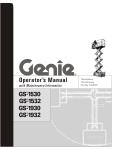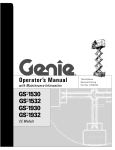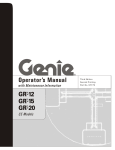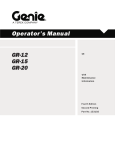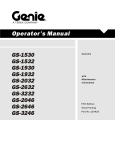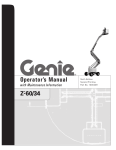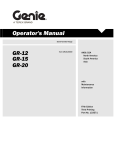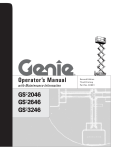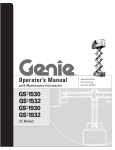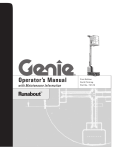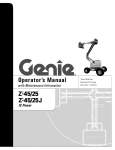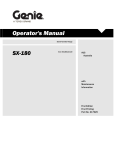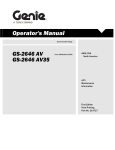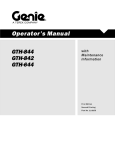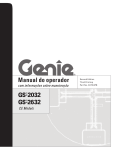Download Operator`s Manual
Transcript
Operator’s Manual GS-1530 GS-1532 GS-1930 GS-1932 GS-2032 GS-2632 GS-3232 GS-2046 GS-2646 GS-3246 CE with Maintenance Information Fifth Edition Third Printing Part No. 114313 Operator's Manual Fifth Edition • Third Printing Important Read, understand and obey these safety rules and operating instructions before operating this machine. Only trained and authorized personnel shall be permitted to operate this machine. This manual should be considered a permanent part of your machine and should remain with the machine at all times. If you have any questions, call Genie Industries. Contents Page Introduction ................................................................ 1 Symbol and Hazard Pictorials Definitions ................... 3 General Safety .......................................................... 5 Personal Safety ......................................................... 7 Work Area Safety ...................................................... 8 Legend ...................................................................... 16 Controls .................................................................... 19 Inspections ............................................................... 23 Operating Instructions .............................................. 38 Transport and Lifting Instructions .............................. 46 Maintenance ............................................................. 50 Specifications ........................................................... 52 Copyright © 1997 by Genie Industries Contact us: Fifth Edition: Internet: www.genielift.com e-mail: [email protected] Third Printing, February 2008 "Genie" is a registered trademark of Genie Industries in the U.S.A. and many other countries. "GS" is a trademark of Genie Industries. Printed on recycled paper Printed in U.S.A. GS-30 • GS-32 • GS-46 Part No. 114313 Operator's Manual Fifth Edition • Third Printing Introduction Owners, Users and Operators: Genie appreciates your choice of our machine for your application. Our number one priority is user safety, which is best achieved by our joint efforts. We feel that you make a major contribution to safety if you, as the equipment users and operators: 1 Comply with employer, job site and governmental rules. 2 Read, understand and follow the instructions in this and other manuals supplied with this machine. 3 Use good safe work practices in a commonsense way. Danger Failure to obey the instructions and safety rules in this manual will result in death or serious injury. Do Not Operate Unless: 4 Only have trained/certified operators, directed by informed and knowledgeable supervision, running the machine. You learn and practice the principles of safe machine operation contained in this operator's manual. If there is anything in this manual that is not clear or which you believe should be added, please contact us. 1 Avoid hazardous situations. Internet: www.genielift.com 2 Always perform a pre-operation inspection. E-mail: [email protected] 3 Always perform function tests prior to use. Know and understand the safety rules before going on to the next section. 4 Inspect the workplace. 5 Only use the machine as it was intended. You read, understand and obey the manufacturer's instructions and safety rules— safety and operator's manuals and machine decals. You read, understand and obey employer's safety rules and work site regulations. You read, understand and obey all applicable governmental regulations. You are properly trained to safely operate the machine. Part No. 114313 GS-30 • GS-32 • GS-46 1 Operator's Manual Fifth Edition • Third Printing Introduction Hazard Classification Intended Use Genie uses symbols, color coding and signal words to identify the following: This machine is intended to be used only to lift personnel, along with their tools and materials to an aerial work site. Safety alert symbol—used to alert you to potential personal injury hazards. Obey all safety messages that follow this symbol to avoid possible injury or death. 2 Red Indicates a hazardous situation which, if not avoided, will result in death or serious injury. Orange Indicates a hazardous situation which, if not avoided, could result in death or serious injury. Yellow Indicates a hazardous situation which, if not avoided, could result in minor or moderate injury. Blue Indicates a hazardous situation which, if not avoided, could result in property damage. Safety Sign Maintenance Replace any missing or damaged safety signs. Keep operator safety in mind at all times. Use mild soap and water to clean safety signs. Do not use solvent-based cleaners because they may damage the safety sign material. GS-30 • GS-32 • GS-46 Part No. 114313 Operator's Manual Fifth Edition • Third Printing Symbol and Hazard Pictorials Definitions Read the operator’s manual Read the service manual Crush hazard Crush hazard Collision hazard Tip-over hazard Tip-over hazard Tip-over hazard Tip-over hazard Electrocution hazard Electrocution hazard Explosion hazard Fire hazard Burn hazard Skin injection hazard Engage safety arm Keep away from moving parts Keep clear of outriggers and tires Move machine to level ground Close chassis tray Maintain required clearance Only trained maintenance personnel should access compartments Use a piece of cardboard or paper to search for leaks Lower the platform Part No. 114313 Do not set up where it cannot be leveled with outriggers GS-30 • GS-32 • GS-46 3 Operator's Manual Fifth Edition • Third Printing Symbol and Hazard Pictorials Definitions Batteries used as counterweights Chock the wheels Release brakes Wheel load Transport diagram Tiedown Voltage rating for power to platform Pressure rating for air line to platform Side force Maximum capacity 4 Outdoor GS-30 • GS-32 • GS-46 Grounded AC 3-wire only Replace damaged wires and cords Lanyard attachment point No smoking Windspeed Indoor Part No. 114313 Operator's Manual Fifth Edition • Third Printing General Safety Safety signs and locations 114371 A 1 2 114338 A 82487 B 82562 B 82474 B 82476 B 82560 B 82475 C 82487 B 82473 C Part No. 114313 82475 C GS-30 • GS-32 • GS-46 5 Operator's Manual Fifth Edition • Third Printing General Safety Safety signs and locations 82476 B 82562 B 82474 B 114337 A 114334 A 82475 C = 153 kg 82481 B 82475 C 114370 A 6 GS-30 • GS-32 • GS-46 Part No. 114313 Operator's Manual Fifth Edition • Third Printing Personal Safety Fall Protection Personal fall protection equipment (PFPE) is not required when operating this machine. If PFPE is required by job site or employer rules, the following shall apply: All PFPE must comply with applicable governmental regulations and must be inspected and used in accordance with the manufacturer’s instructions. Part No. 114313 GS-30 • GS-32 • GS-46 7 Operator's Manual Fifth Edition • Third Printing Work Area Safety Tip-over Hazards Electrocution Hazards This machine is not electrically insulated and will not provide protection from contact with or proximity to electrical current. Occupants, equipment and materials must not exceed the maximum platform capacity. Models without capacity indicator: Maximum Capacity Maintain safe distances from electrical power lines and apparatus in accordance with applicable governmental regulations and the following chart. Line Voltage GS-1530 and GS-1532 272 kg GS-1930 and GS-1932 227 kg GS-2032 363 kg GS-2632 227 kg GS-3232 227 kg GS-2046 544 kg GS-2646 454 kg GS-3246 318 kg Required Clearance 0 to 50KV 3.05 m Models with capacity indicator: 50KV to 200KV 4.60 m 200KV to 350KV 6.10 m The maximum capacity varies with the height of the platform. 350KV to 500KV 7.62 m 500KV to 750KV 10.67 m Height of platform 750KV to 1000KV 13.72 m 4.6 m 272 kg 4m 390 kg 2.8 m 484 kg 1.6 m 390 kg 1m 344 kg Allow for platform movement, electrical line sway or sag and beware of strong or gusty winds. Keep away from the machine if it contacts energized power lines. Personnel on the ground or in the platform must not touch or operate the machine until energized power lines are shut off. Maximum Capacity - GS-1530 and GS-1532 Maximum Capacity Maximum Capacity - GS-1930 and GS-1932 Do not operate the machine during lightning or storms. Height of platform 5.8 m 227 kg Do not use the machine as a ground for welding. 5.2 m 320 kg 3.7 m 435 kg 1.6 m 320 kg 1m 227 kg 8 GS-30 • GS-32 • GS-46 Maximum Capacity Part No. 114313 Operator's Manual Fifth Edition • Third Printing Work Area Safety Maximum Capacity - GS-2032 Height of platform Maximum Capacity - GS-2046 Maximum Capacity Height of platform Maximum Capacity 6m 363 kg 6m 544 kg 5.7 m 512 kg 5.7 m 744 kg 3.5 m 693 kg 3.5 m 985 kg 2.4 m 608 kg 2.4 m 873 kg 1m 454 kg 1m 635 kg Maximum Capacity - GS-2632 Height of platform Maximum Capacity - GS-2646 Maximum Capacity Height of platform Maximum Capacity 7.9 m 227 kg 7.9 m 454 kg 6.4 m 442 kg 5.9 m 744 kg 4.5 m 479 kg 4.5 m 798 kg 2.8 m 409 kg 2.8 m 701 kg 1m 281 kg 1m 454 kg Maximum Capacity - GS-3232 Height of platform Maximum Capacity - GS-3246 Maximum Capacity Height of platform Maximum Capacity 9.8 m 227 kg 9.8 m 318 kg 9.1 m 344 kg 9.1 m 483 kg 5.4 m 498 kg 5.4 m 699 kg 3.5 m 433 kg 3.5 m 608 kg 1m 227 kg 1m 318 kg Part No. 114313 GS-30 • GS-32 • GS-46 9 Operator's Manual Fifth Edition • Third Printing Work Area Safety Do not raise the platform unless the machine is on a firm, level surface. Do not depend on the tilt alarm as a level indicator. The tilt alarm sounds on the chassis only when the machine is on a slope. If the tilt alarm sounds: Lower the platform. Move the machine to a firm, level surface. If the tilt alarm sounds when the platform is raised, use extreme caution to lower the platform. Do not drive over 0.8 km/h with the platform raised. Outdoor Use: Do not raise the platform when wind speeds may exceed 12.5 m/s. If wind speeds exceed 12.5 m/s when the platform is raised, lower the platform and do not continue to operate the machine. Indoor Use: When raising the platform, follow ratings for allowable side force and number of occupants on the next page. Do not operate the machine in strong or gusty winds. Do not increase the surface area of the platform or the load. Increasing the area exposed to the wind will decrease machine stability. Use extreme care and slow speeds while driving the machine in a stowed position across uneven terrain, debris, unstable or slippery surfaces and near holes and drop-offs. Do not drive the machine on or near uneven terrain, unstable surfaces or other hazardous conditions with the platform raised. Do not use the machine as a crane. Do not push the machine or other objects with the platform. Do not contact adjacent structures with the platform. Do not tie the platform to adjacent structures. Do not place loads outside the platform perimeter. Do not operate the machine with the chassis trays open. 10 GS-30 • GS-32 • GS-46 Part No. 114313 Operator's Manual Fifth Edition • Third Printing Work Area Safety Do not push off or pull toward any object outside of the platform. Do not replace items critical to machine stability with items of different weight or specification. Do not use batteries that weigh less than the original equipment. Batteries are used as counterweight and are critical to machine stability. Each battery must weigh 29.5 kg. Battery box including batteries must weigh a minimum of 152 kg. Maximum allowable manual force Manual Force Maximum Occupants GS-1530 400 N Indoor use only - 2 GS-1532 400 N 200 N Indoor - 2 Outdoor - 1 GS-1930 400 N Indoor use only - 2 GS-1932 400 N 200 N Indoor - 2 Outdoor - 1 GS-2032 400 N 200 N Indoor - 2 Outdoor - 1 GS-2632 400 N Indoor use only - 2 GS-3232 400 N Indoor use only - 2 GS-2046 400 N Indoor/Outdoor - 2 GS-2646 400 N Indoor/Outdoor - 2 GS-3246 400 N 200 N Indoor - 2 Outdoor - 1 Model Do not alter or disable the limit switches. Do not alter or disable machine components that in any way affect safety and stability. Part No. 114313 Do not modify or alter an aerial work platform without prior written permission from the manufacturer. Mounting attachments for holding tools or other materials onto the platform, toeboards or guard rail system can increase the weight in the platform and the surface area of the platform or the load. Do not place or attach fixed or overhanging loads to any part of this machine. Do not place ladders or scaffolds in the platform or against any part of this machine. Do not transport tools and materials unless they are evenly distributed and can be safely handled by person(s) in the platform. Do not use the machine on a moving or mobile surface or vehicle. Be sure all tires are in good condition, castle nuts are properly tightened and cotter pins are properly installed. GS-30 • GS-32 • GS-46 11 Operator's Manual Fifth Edition • Third Printing Work Area Safety If equipped with outriggers Fall Hazards Do not set the machine up where it cannot be leveled using only the outriggers. Do not adjust the outriggers while the platform is raised. Do not drive while the outriggers are lowered. Crushing Hazard The guard rail system provides fall protection. If occupants of the platform are required to wear personal fall protection equipment (PFPE) due to job site or employer rules, PFPE and its use shall be in accordance with the PFPE manufacturer’s instructions and applicable governmental requirements. Use approved lanyard attachment point provided. Keep hands and limbs out of scissors. Keep the platform floor clear of debris. Keep hands clear when folding rails. Attach the platform entry chain or close the entry gate before operating. Do not work under the platform or in the scissor links without the safety arm in place. Use common sense and planning when operating the machine with the controller from the ground. Maintain safe distances between the operator, the machine and fixed objects. Operation on Slopes Hazards Do not operate the machine unless the guard rails are properly installed and the entry is secured for operation. Do not sit, stand or climb on the platform guard rails. Maintain a firm footing on the platform floor at all times. Do not drive the machine on a slope that exceeds the slope and side slope rating of the machine. Slope rating applies to machines in the stowed position. Maximum slope rating stowed position Maximum side slope rating stowed position GS-1530 30% (17°) 30% (17°) GS-1532 30% (17°) 30% (17°) GS-1930 25% (14°) 25% (14°) GS-1932 25% (14°) 25% (14°) GS-2032 30% (17°) 30% (17°) GS-2632 25% (14°) 25% (14°) GS-3232 25% (14°) 25% (14°) GS-2046 30% (17°) 30% (17°) GS-2646 30% (17°) 30% (17°) GS-3246 25% (14°) 25% (14°) Model Do not climb down from the platform when raised. Do not enter or exit the platform unless the machine is in the stowed position. Note: Slope rating is subject to ground conditions and adequate traction. 12 GS-30 • GS-32 • GS-46 Part No. 114313 Operator's Manual Fifth Edition • Third Printing Work Area Safety Do not lower the platform unless the area below is clear of personnel and obstructions. Collision Hazards Be aware of limited sight distance and blind spots when driving or operating. Be aware of extended platform position when moving the machine. The machine must be on a level surface or secured before releasing the brakes. Check the work area for overhead obstructions or other possible hazards. Limit travel speed according to the condition of the ground surface, congestion, slope, location of personnel, and any other factors which may cause collision. Do not operate a machine in the path of any crane or moving overhead machinery unless the controls of the crane have been locked out and/or precautions have been taken to prevent any potential collision. Be aware of crushing hazards when grasping the platform guard rail. No stunt driving or horseplay while operating a machine. Operators must comply with employer, job site and governmental rules regarding use of personal protective equipment. Part No. 114313 GS-30 • GS-32 • GS-46 13 Operator's Manual Fifth Edition • Third Printing Work Area Safety Bodily Injury Hazard Damaged Machine Hazards Do not operate the machine with a hydraulic oil or air leak. An air leak or hydraulic leak can penetrate and/or burn skin. Improper contact with components under any cover will cause serious injury. Only trained maintenance personnel should access compartments. Access by the operator is only advised when performing a pre-operation inspection. All compartments must remain closed and secured during operation. Explosion and Fire Hazards Do not operate the machine or charge the battery in hazardous locations or locations where potentially flammable or explosive gases or particles may be present. Do not use a damaged or malfunctioning machine. Conduct a thorough pre-operation inspection of the machine and test all functions before each work shift. Immediately tag and remove from service a damaged or malfunctioning machine. Be sure all maintenance has been performed as specified in this manual and the appropriate service manual. Be sure all decals are in place and legible. Be sure the operator’s, safety, and responsibilities manuals are complete, legible and in the storage container located on the platform. Component Damage Hazards Do not use any battery charger greater than 24V to charge the batteries. Do not use the machine as a ground for welding. 14 GS-30 • GS-32 • GS-46 Part No. 114313 Operator's Manual Fifth Edition • Third Printing Work Area Safety Battery Safety Electrocution/Burn Hazards Connect the battery charger to a grounded, AC 3-wire electrical outlet only. Burn Hazards Batteries contain acid. Always wear protective clothing and eye wear when working with batteries. Avoid spilling or contacting battery acid. Neutralize battery acid spills with baking soda and water. Do not expose the batteries or the charger to water or rain during charging. Explosion Hazards Keep sparks, flames and lighted tobacco away from batteries. Batteries emit an explosive gas. The battery tray should remain open during the entire charging cycle. Do not contact the battery terminals or the cable clamps with tools that may cause sparks. Component Damage Hazard Do not use any battery charger greater than 24V to charge the batteries. Inspect daily for damaged cords, cables and wires. Replace damaged items before operating. Avoid electrical shock from contact with battery terminals. Remove all rings, watches and other jewelry. Tip-over Hazard Do not use batteries that weigh less than the original equipment. Batteries are used as counterweight and are critical to machine stability. Each battery must weigh 29.5 kg. Battery tray including batteries must weigh a minimum of 152 kg. Lifting Hazard Use the appropriate number of people and proper lifting techniques when lifting batteries. Lockout After Each Use 1 Select a safe parking location—firm level surface, clear of obstruction and traffic. 2 Lower the platform. 3 Turn the key switch to the off position and remove the key to secure from unauthorized use. 4 Chock the wheels. 5 Charge the batteries. Part No. 114313 GS-30 • GS-32 • GS-46 15 Operator's Manual Fifth Edition • Third Printing Legend GS-1530 GS-1532 GS-1930 GS-1932 1 Platform guard rails 2 Lanyard anchorage point 1 2 3 2 4 5 6 3 Air line to platform (optional) 4 Manual storage container 5 Platform controls 6 Platform extension 7 Transport tie-down 8 Steer tire 9 Pothole guard 10 LED diagnostic readout 11 Ground controls 12 Non-steer tire 23 13 Emergency lowering knob 22 14 Brake release pump 15 Entry ladder/transport tie-down 21 16 Battery charger (on opposite side of machine) 20 17 Tilt alarm (under cover) 18 Inverter (optional) 19 19 Safety arm 20 GFCI outlet 21 Capacity indicator (if equipped) 22 Platform extension release pedal 18 23 Platform entry chain or gate 17 16 15 14 7 13 8 7 12 16 11 10 9 GS-30 • GS-32 • GS-46 Part No. 114313 Operator's Manual Fifth Edition • Third Printing Legend 1 2 3 4 Platform guard rails Lanyard anchorage point Air line to platform (optional) Outrigger controls GS-3232 models 5 Platform controls 6 Platform extension 7 Manual storage container 8 Emergency lowering knob 9 Transport tie-down 10 Steer tire 11 Outrigger - GS-3232 models 12 Pothole guard 13 LED diagnostic readout 14 Ground controls 15 Non-steer tire 16 Brake release pump 17 Entry ladder/transport tie-down 18 Battery charger (on opposite side of machine) 19 Tilt alarm (under cover) 20 Inverter (optional) 21 Safety arm 22 GFCI outlet 23 Platform extension release pedal 24 Capacity indicator (if equipped) 25 Platform entry chain or gate 26 Outrigger control ECM GS-3232 models GS-2032 GS-2632 GS-3232 Part No. 114313 GS-30 • GS-32 • GS-46 17 Operator's Manual Fifth Edition • Third Printing Legend 1 Lanyard anchorage point GS-2046 GS-2646 GS-3246 2 Platform guard rails 3 Air line to platform (optional) 4 Manual storage container 5 Platform controls 6 Platform extension 7 Transport tie-down 8 Steer tire 9 Pothole guard 10 LED diagnostic readout 11 Ground controls 12 Non-steer tire 13 Emergency lowering knob 14 Brake release pump 15 Entry ladder/transport tie-down 16 Battery charger (on opposite side of machine) 17 Tilt alarm (under cover) 18 Inverter (optional) 19 Safety arm 20 GFCI outlet 21 Platform extension release pedal 22 Capacity indicator (if equipped) 23 Platform entry chain or gate 18 GS-30 • GS-32 • GS-46 Part No. 114313 Operator's Manual Fifth Edition • Third Printing Controls Ground Control Panel 4 Platform up/down toggle switch 1 7 amp breaker for electric circuits 2 Key switch for platform/off/ground selection Turn the key switch to the platform position and the platform controls will operate. Turn the key switch to the off position and the machine will be off. Turn the key switch to the base position and the ground controls will operate. 3 Hour meter Move the switch up and the platform will raise. Move the switch down and the platform will lower. 5 Red Emergency Stop button Push in the red Emergency Stop button to the off position to stop all functions. Pull out the red Emergency Stop button to the on position to operate the machine. Indicates the number of hours the machine has been put into use. Part No. 114313 GS-30 • GS-32 • GS-46 19 Operator's Manual Fifth Edition • Third Printing Controls Platform Control Panel 1 Thumb rocker switch for steer functions 5 LED 2 Drive speed button 6 Lift function select button 3 Drive function select button 7 Horn button 4 Red Emergency Stop button 8 Proportional control handle and function enable switch for lift and drive functions 20 GS-30 • GS-32 • GS-46 Part No. 114313 Operator's Manual Fifth Edition • Third Printing Controls Platform Control Panel 7 Horn Button 1 Thumb rocker switch for steer functions Press the thumb rocker switch in either direction to activate steer function. 2 Drive speed button Press this button to activate the slow or fast drive function. 3 Drive function select button Press this button to activate the drive function. 4 Red Emergency Stop button Push in the red Emergency Stop button to the off position to stop all functions. Pull out the red Emergency Stop button to the on position to operate the machine. 5 LED Push the horn button and the horn will sound. Release the horn button and the horn will stop. 8 Proportional control handle and function enable switch for lift and drive functions Lift function: Move the control handle in the direction indicated by the blue arrow and the platform will raise. Move the control handle in the direction indicated by the yellow arrow and the platform will lower. The descent alarm will sound while the platform is lowering. Drive function: Move the control handle in the direction indicated by the blue arrow on the control panel and the machine will move in the direction that the blue arrow points. Move the control handle in the direction indicated by the yellow arrow on the control panel and the machine will move in the direction that the yellow arrow points. Diagnostic read out, battery charge indicator and platform overload indicator. 6 Lift function select button Press this button to activate the lift function. Part No. 114313 GS-30 • GS-32 • GS-46 21 Operator's Manual Fifth Edition • Third Printing Controls Outrigger Control Panel, GS-3232 models 1 Lift enable indicator 4 Function enable button Turns green to indicate that the up/down functions can be operated. 2 Lift error indicator light 5 Outrigger extend button Turns red to indicate that the up/down functions cannot be operated. 3 Individual outrigger function indicator lights Turns solid green to indicate the outriggers made contact with the ground. Flashes red or solid red to indicate an error. 22 Press and hold the button to activate the outrigger extend or outrigger retract button. Press this button and the outriggers will extend. 6 Outrigger retract button Press this button and the outriggers will retract. GS-30 • GS-32 • GS-46 Part No. 114313 Operator's Manual Fifth Edition • Third Printing Inspections Pre-operation Inspection Fundamentals It is the responsibility of the operator to perform a pre-operation inspection and routine maintenance. Do Not Operate Unless: You learn and practice the principles of safe machine operation contained in this operator's manual. 1 Avoid hazardous situations. 2 Always perform a pre-operation inspection. Know and understand the pre-operation inspection before going on to the next section. 3 Always perform function tests prior to use. 4 Inspect the workplace. 5 Only use the machine as it was intended. The pre-operation inspection is a visual inspection performed by the operator prior to each work shift. The inspection is designed to discover if anything is apparently wrong with a machine before the operator performs the function tests. The pre-operation inspection also serves to determine if routine maintenance procedures are required. Only routine maintenance items specified in this manual may be performed by the operator. Refer to the list on the next page and check each of the items. If damage or any unauthorized variation from factory delivered condition is discovered, the machine must be tagged and removed from service. Repairs to the machine may only be made by a qualified service technician, according to the manufacturer's specifications. After repairs are completed, the operator must perform a pre-operation inspection again before going on to the function tests. Scheduled maintenance inspections shall be performed by qualified service technicians, according to the manufacturer's specifications and the requirements listed in the responsibilities manual. Part No. 114313 GS-30 • GS-32 • GS-46 23 Operator's Manual Fifth Edition • Third Printing Inspections Pre-operation Inspection R R R R Be sure that the operator’s, safety and responsibilities manuals are complete, legible and in the storage container located in the platform. Be sure that all decals are legible and in place. See Inspections section. Check the following components or areas for damage, improperly installed or missing parts and unauthorized modifications: R 24 Electrical components, wiring and electrical cables R Hydraulic hoses, fittings, cylinders and manifolds R Battery pack and connections R Drive motors R Wear pads R Tires and wheels R Ground strap R Limit switches, alarms and horn R Alarms and beacons (if equipped) R Nuts, bolts and other fasteners R Platform entry chain or gate R Brake release components R Safety arm R Platform overload components Pothole guards R Platform extension R Scissor pins and retaining fasteners R Platform control joystick Check entire machine for: Check for hydraulic oil leaks and proper oil level. Add oil if needed. See Maintenance section. Check for battery fluid leaks and proper fluid level. Add distilled water if needed. See Maintenance section. R R Cracks in welds or structural components R Dents or damage to machine R Excessive rust, corrosion or oxidation R Be sure that all structural and other critical components are present and all associated fasteners and pins are in place and properly tightened. R Be sure side rails are installed and bolts are fastened. R Be sure that the chassis trays are closed and latched and the batteries are properly connected. Note: If the platform must be raised to inspect the machine, make sure the safety arm is in place. See Operating Instructions section. GS-30 • GS-32 • GS-46 Part No. 114313 Operator's Manual Fifth Edition • Third Printing Inspections Function Test Fundamentals The function tests are designed to discover any malfunctions before the machine is put into service. The operator must follow the step-by-step instructions to test all machine functions. Do Not Operate Unless: You learn and practice the principles of safe machine operation contained in this operator's manual. A malfunctioning machine must never be used. If malfunctions are discovered, the machine must be tagged and removed from service. Repairs to the machine may only be made by a qualified service technician, according to the manufacturer's specifications. 1 Avoid hazardous situations. After repairs are completed, the operator must perform a pre-operation inspection and function tests again before putting the machine into service. 2 Always perform a pre-operation inspection. 3 Always perform function tests prior to use. Know and understand the function tests before going on to the next section. 4 Inspect the workplace. 5 Only use the machine as it was intended. Part No. 114313 GS-30 • GS-32 • GS-46 25 Operator's Manual Fifth Edition • Third Printing Inspections 1 Select a test area that is firm, level and free of obstruction. 2 Be sure the battery pack is connected. At the Ground Controls 3 Pull out the platform and ground red Emergency Stop buttons to the on position. 8 Activate the up function. Result: The platform should raise. 9 Activate the down function. Result: The platform should lower. The descent alarm should sound while the platform is lowering. 4 Turn the key switch to ground control. Test Emergency Lowering 5 Observe the diagnostic LED readout on the platform controls. 10 Activate the up function and raise the platform approximately 60 cm. Result: The LED should look like the picture at right. 11 Pull the emergency lowering knob located behind the entry ladder. Test Emergency Stop 6 Push in the ground red Emergency Stop button to the off position. Result: No functions should operate. Result: The platform should lower. The descent alarm will not sound. 12 Turn the key switch to platform control. At the Platform Controls 7 Pull out the red Emergency Stop button to the on position. Test Emergency Stop Test the Up/Down Functions 13 Push in the platform red Emergency Stop button to the off position. The audible warnings on this machine and the standard horn all come from the same central alarm. The horn is a constant tone. The descent alarm sounds at 60 beeps per minute. The alarm that goes off when the pothole guards have not deployed sounds at 300 beeps per minute. The alarm that goes off when the machine is not level sounds at 600 beeps per minute. An optional automotive-style horn is also available. 26 Result: No functions should operate. Test the Horn 14 Pull out the red Emergency Stop button to the on position. 15 Push the horn button. Result: The horn should sound. GS-30 • GS-32 • GS-46 Part No. 114313 Operator's Manual Fifth Edition • Third Printing Inspections Test the Function Enable Switch Test the Steering 16 Do not hold the function enable switch on the control handle. Note: When performing the steer and drive function tests, stand in the platform facing the steer end of the machine. 17 Slowly move the control handle in the direction indicated by the blue arrow, then in the direction indicated by the yellow arrow. Result: No functions should operate. 23 Press the drive function select switch. 24 Press and hold the function enable switch on the control handle. Test the Up/Down Functions 25 Depress the thumb rocker switch on top of the control handle in the direction identified by the blue triangle on the control panel. 18 Press the lift function select button. 19 Press and hold the function enable switch on the control handle. 20 Slowly move the control handle in the direction indicated by the blue arrow. Result: The platform should raise. The pothole guards should deploy. 21 Release the control handle. Result: The platform should stop raising. Result: The steer wheels should turn in the direction that the blue triangle points on the control panel. 26 Depress the thumb rocker switch in the direction identified by the yellow triangle on the control panel. Result: The steer wheels should turn in the direction that the yellow triangle points on the control panel. 22 Press and hold the function enable switch. Slowly move the control handle in the direction indicated by the yellow arrow. Result: The platform should lower. The descent alarm should sound while the platform is lowering. When lowering the platform, the platform should stop when it is approximately 2.1 m from the ground. Be sure the area below the platform is clear of personnel and obstructions before continuing. To continue lowering, release the control handle, wait 5 seconds, then move the control handle again. Part No. 114313 GS-30 • GS-32 • GS-46 27 Operator's Manual Fifth Edition • Third Printing Inspections Test Drive and Braking Test the Tilt Sensor Operation 27 Press and hold the function enable switch. Note: Perform this test from the ground with the platform controller. Do not stand in the platform. 28 Slowly move the control handle in the direction indicated by the blue arrow on the control panel until the machine begins to move, then return the handle to the center position. Result: The machine should move in the direction that the blue arrow points on the control panel, then come to an abrupt stop. 29 Slowly move the control handle in the direction indicated by the yellow arrow on the control panel until the machine begins to move, then return the handle to the center position. Result: The machine should move in the direction that the yellow arrow points on the control panel, then come to an abrupt stop. Note: The brakes must be able to hold the machine on any slope it is able to climb. 30 Fully lower the platform. 31 Place a 2x4 or similar piece of wood under both wheels on one side and drive the machine up onto them. 32 Raise the platform approximately 2.1 m from the ground. Result: The platform should stop elevating and the tilt alarm will sound at 600 beeps per minute. 33 Move the drive control handle in the direction indicated by the blue arrow, then move the drive control handle in the direction indicated by the yellow arrow. Result: The drive function should not work in either direction. 34 Lower the platform and remove both pieces of wood. 28 GS-30 • GS-32 • GS-46 Part No. 114313 Operator's Manual Fifth Edition • Third Printing Inspections Test Limited Drive Speed Test the Pothole Guards 35 Press the lift function select button. Note: The pothole guards should automatically deploy when the platform is raised. The pothole guards activate another limit switch which allows the machine to continue to function. If the pothole guards do not deploy, an alarm sounds and the machine will not drive. 36 Press and hold the function enable switch. Raise the platform approximately 1.2 m from the ground. Result: The pothole guards should deploy. 37 Press the drive function select switch. 38 Press and hold the function enable switch. Slowly move the control handle to the full drive position. Result: The maximum achievable drive speed with the platform raised should not exceed 20 cm/s. If the drive speed with the platform raised exceeds 20 cm/s, immediately tag and remove the machine from service. 39 Raise the platform. Result: When the platform is raised 1.2 m from the ground, the pothole guards should deploy. 40 Press on the pothole guards on one side, and then the other. Result: The pothole guards should not move. 41 Lower the platform. Result: The pothole guards should return to the stowed position. 42 Place a 2x4 or similar piece of wood under a pothole guard. Raise the platform. Result: Before the platform is raised 2.1 m from the ground, an alarm should sound and the drive function should not work. 43 Lower the platform and remove the 2x4. Part No. 114313 GS-30 • GS-32 • GS-46 29 Operator's Manual Fifth Edition • Third Printing Inspections 50 Press and hold the function enable switch on the control handle. Test the Outrigger System 44 Press the lift function select button. 45 Press and hold the function enable switch on the control handle. 46 Slowly move the control handle in the direction indicated by the blue arrow. Result: The platform should raise to 6.7 m and stop. The lift error indicator light will turn on. 47 Fully lower the platform. Result: The platform should raise to 32 ft / 9.8 m and stop. 52 Fully lower the platform. 53 Press and hold the outrigger retract button. Result: The outriggers should not retract. 48 Press and hold the outrigger extend button. 54 Press and hold the function enable button. Press and hold the outrigger retract button. Result: The outriggers should not extend. 49 Press and hold the function enable button. Press and hold the outrigger extend button. Result: The outriggers should extend. The individual outrigger LED indicator lights will turn green as the corresponding outrigger makes contact with the ground. Continue pressing the function enable and the outrigger extend buttons until the lift enable indicator light turns green and a beep is heard. The machine is now level. At this point, the drive and steer functions are disabled. 30 51 Slowly move the control handle in the direction indicated by the blue arrow. Result: The outriggers should start retracting. Release the function enable and the outrigger retract buttons once the outriggers are off the ground. After approximately 5 seconds, the outrigger indicator lights will turn off. All functions are now restored. Note: The machine drive speeds are reduced the first time the drive function is enabled after retracting the outriggers. The drive speeds are restored to normal after driving for approximately 6 seconds. GS-30 • GS-32 • GS-46 Part No. 114313 Operator's Manual Fifth Edition • Third Printing Inspections Fundamentals The workplace inspection helps the operator determine if the workplace is suitable for safe machine operation. It should be performed by the operator prior to moving the machine to the workplace. Do Not Operate Unless: You learn and practice the principles of safe machine operation contained in this operator's manual. It is the operator's responsibility to read and remember the workplace hazards, then watch for and avoid them while moving, setting up and operating the machine. 1 Avoid hazardous situations. Workplace Inspection 2 Always perform a pre-operation inspection. Be aware of and avoid the following hazardous situations: 3 Always perform function tests prior to use. 4 Inspect the workplace. Know and understand the workplace inspection before going on to the next section. 5 Only use the machine as it was intended. Part No. 114313 • drop-offs or holes • bumps, floor obstructions or debris • sloped surfaces • unstable or slippery surfaces • overhead obstructions and high voltage conductors • hazardous locations • inadequate surface support to withstand all load forces imposed by the machine • wind and weather conditions • the presence of unauthorized personnel • other possible unsafe conditions GS-30 • GS-32 • GS-46 31 Operator's Manual Fifth Edition • Third Printing Inspections Decal Inspection for models GS-1530, GS-1532, GS-1930 and GS-1932 Use the pictures on the next page to verify that all decals are legible and in place. Below is a numerical list with quantities and descriptions. Part No. Description Quantity Part No. Description Quantity 28174 Label - Power to Platform, 230V 2 82567 Ground Control Panel 1 28235 Label - Power to Platform, 115V 2 82568 Cosmetic - Genie GS-1532 2 40434 Label - Lanyard Anchorage 5 82570 4 43618 Label - Directional Arrows 2 Label - Wheel Load, GS-1530 and GS-1532 43658 Label - Power to Charger, 230V 1 82571 4 44980 Label - Power to Charger, 115V 1 Label - Wheel Load, GS-1930 and GS-1932 82664 Label - Air to Platform, 110 PSI 2 Label - Maximum Capacity, GS-1530 and GS-1532 1 44981 52475 Label - Transport Tie-down 5 82665 1 62053 Cosmetic - Genie GS-1530 2 Label - Maximum Capacity, GS-1930 and GS-1932 62054 Cosmetic - Genie GS-1930 2 82668 1 72086 Label - Lifting Eye 4 Label - Capacity Indicator, GS-1530 and GS-1532 (if equipped) 72143 Label - Emergency Stop 1 82669 Label - Capacity Indicator, GS-1930 and GS-1932 (if equipped) 1 82287 Cosmetic - Genie GS-1932 2 97582 Label - Compartment Access 1 Label - Manual Force, 400N, GS-1530 and GS-1930 1 82473 82474 Label - Use Safety Chock 2 97719 Label - Safety Arm 1 82476 Label - Electrocution Hazard 2 97772 Platform Control Panel 1 82481 Label - Battery/Charger Safety 1 114334 Label - Electrocution hazard, Plug 1 82482 Label - Emergency Lowering 1 114337 Label - Tip-over Hazard, Limit Switch 1 82487 Label - Read the Manual 2 114338 Label - Tip-over Hazard, Tilt Alarm 1 82495 Label - Brake Release Safety and Operating Instructions 2 114361 Label - Transport Diagram 2 114370 Label - Tip-over Hazard, Batteries 1 82497 Label - Manual Force, 200N/400N, GS-1532 and GS-1932 1 114371 Label - Outrigger Safety 1 82502 Label - LED Diagnostic Readout 1 114372 Label - Tip-over Hazard, Open Trays 2 82560 Label - Skin Injection Hazard 1 133239 Label - Maximum Capacity, GS-1530 & GS-1532 1 82562 Label - Crushing Hazard 4 Label - Maximum Capacity, GS-1930 & GS-1932 1 32 133240 GS-30 • GS-32 • GS-46 Part No. 114313 Operator's Manual Fifth Edition • Third Printing Inspections Decal Plate Ground Controls Side Battery Side Part No. 114313 GS-30 • GS-32 • GS-46 33 Operator's Manual Fifth Edition • Third Printing Inspections Decal Inspection for models GS-2032, GS-2632 and GS-3232 Use the pictures on the next page to verify that all decals are legible and in place. Below is a numerical list with quantities and descriptions. Part No. Description Quantity 28174 Label - Power to Platform, 230V 2 28235 Label - Power to Platform, 115V 2 Part No. Description Quantity 97684 Label - Capacity Indicator, GS-2632 (if equipped) 1 Label - Maximum Capacity, GS-2032 1 40434 Label - Lanyard Anchorage 5 97685 43618 Label - Directional Arrows 2 97686 Label - Maximum Capacity, GS-2632 1 43658 Label - Power to Charger, 230V 1 97692 Label - Wheel Load, GS-2032 4 44980 Label - Power to Charger, 115V 1 97693 Label - Wheel Load, GS-2632 4 44981 Label - Air to Platform, 110 PSI 2 97719 Label - Safety Arm 1 Platform Control Panel 1 52475 Label - Transport Tie-down 5 97772 62055 Cosmetic - Genie GS-2032 2 114136 Outrigger Control Panel 1 72086 Label - Lifting Eye 4 114324 Cosmetic - Genie GS-3232 2 72143 Label - Emergency Stop 1 114334 Label - Electrocution hazard, Plug 1 72973 Cosmetic - Genie GS-2632 2 114337 Label - Tip-over Hazard, Limit Switch 1 Label - Tip-over Hazard, Tilt Alarm 1 82473 Label - Compartment Access 1 114338 82474 Label - Use Safety Chock 2 114361 Label - Transport Diagram 2 82475 Label - Foot Crushing Hazard 4 114362 Label - Wheel Load, GS-3232 4 82476 Label - Electrocution Hazard 2 114368 82481 Label - Battery/Charger Safety 1 Label - Capacity Indicator, GS-3232 (if equipped) 1 82482 Label - Emergency Lowering 1 114370 Label - Tip-over Hazard, Batteries 1 82487 Label - Read the Manual 2 114371 Label - Outrigger Safety 1 82495 Label - Brake Release Safety and Operating Instructions 1 114372 Label - Tip-over Hazard, Open Trays 2 114434 Label - Maximum Capacity, GS-3232 1 Label - Maximum Capacity, GS-2032 1 Label - Maximum Capacity, GS-2632 & GS-3232 1 82497 Label - Manual Force, GS-2032 1 133241 82502 Label - LED Diagnostic Readout 1 133242 82560 Label - Skin Injection Hazard 1 82562 Label - Crushing Hazard 4 82567 Ground Control Panel 1 97582 Label - Manual Force, GS-2632 and GS-3232 1 97683 Label - Capacity Indicator, GS-2032 (if equipped) 34 1 GS-30 • GS-32 • GS-46 Part No. 114313 Operator's Manual Fifth Edition • Third Printing Inspections Decal Plate Ground Controls Side Battery Side Part No. 114313 GS-30 • GS-32 • GS-46 35 Operator's Manual Fifth Edition • Third Printing Inspections Decal Inspection for models GS-2046, GS-2646 and GS-3246 Use the pictures on the next page to verify that all decals are legible and in place. Below is a numerical list with quantities and descriptions. Part No. Description Quantity Part No. Description Quantity 28174 Label - Power to Platform, 230V 2 82705 Label - Wheel Load, GS-3246 4 28235 Label - Power to Platform, 115V 2 82787 Label - Maximum Capacity, GS-2046 1 40434 Label - Lanyard Anchorage 5 82788 Label - Maximum Capacity, GS-2646 1 43618 Label - Directional Arrows 2 82789 Label - Maximum Capacity, GS-3246 1 43658 Label - Power to Charger, 230V 1 82790 44980 Label - Power to Charger, 115V 1 Label - Capacity Indicator, GS-2046 (if equipped) 1 82791 Label - Capacity Indicator, GS-2646 (if equipped) 1 Label - Capacity Indicator, GS-3246 (if equipped) 1 44981 Label - Air to Platform, 110 PSI 2 52475 Label - Transport Tie-down 5 62056 Cosmetic - Genie GS-2046 2 62057 Cosmetic - Genie GS-2646 2 82905 Label - Manual Force, GS-2046, GS-2646 1 62058 Cosmetic - Genie GS-3246 2 97719 Label - Safety Arm 1 72086 Label - Lifting Eye 4 97772 Platform Control Panel 1 72143 Label - Emergency Stop 1 114334 Label - Electrocution hazard, Plug 1 82473 Label - Compartment Access 1 114337 Label - Tip-over Hazard, Limit Switch 1 82474 Label - Use Safety Chock 2 114338 Label - Tip-over Hazard, Tilt Alarm 1 82476 Label - Electrocution Hazard 2 114361 Label - Transport Diagram 2 82481 Label - Battery/Charger Safety 1 114370 Label - Tip-over Hazard, Batteries 1 82482 Label - Emergency Lowering 1 114372 Label - Tip-over Hazard, Open Trays 2 82487 Label - Read the Manual 2 133243 Label - Maximum Capacity, GS-2046 1 82495 Label - Brake Release Safety and Operating Instructions 1 133244 Label - Maximum Capacity, GS-2646 1 82497 Label - Manual Force, GS-3246 1 133245 Label - Maximum Capacity, GS-3246 1 82502 Label - LED Diagnostic Readout 1 82560 Label - Skin Injection Hazard 1 82562 Label - Crushing Hazard 4 82567 Ground Control Panel 1 82703 Label - Wheel Load, GS-2046 4 82704 Label - Wheel Load, GS-2646 4 36 82792 GS-30 • GS-32 • GS-46 Part No. 114313 Operator's Manual Fifth Edition • Third Printing Inspections Decal Plate Ground Controls Side Battery Side Part No. 114313 GS-30 • GS-32 • GS-46 37 Operator's Manual Fifth Edition • Third Printing Operating Instructions Fundamentals The Operating Instructions section provides instructions for each aspect of machine operation. It is the operator's responsibility to follow all the safety rules and instructions in the operator's, safety and responsibilities manuals. Do Not Operate Unless: You learn and practice the principles of safe machine operation contained in this operator's manual. 1 Avoid hazardous situations. 2 Always perform a pre-operation inspection. 3 Always perform function tests prior to use. 4 Inspect the workplace. 5 Only use the machine as it was intended. 38 Using the machine for anything other than lifting personnel, along with their tools and materials, to an aerial work site is unsafe and dangerous. Only trained and authorized personnel should be permitted to operate a machine. If more than one operator is expected to use a machine at different times in the same work shift, they must all be qualified operators and are all expected to follow all safety rules and instructions in the operator's, safety and responsibilities manuals. That means every new operator should perform a pre-operation inspection, function tests, and a workplace inspection before using the machine. GS-30 • GS-32 • GS-46 Part No. 114313 Operator's Manual Fifth Edition • Third Printing Operating Instructions Emergency Stop Operation From Platform Push in the red Emergency Stop button to the off position at the ground controls or the platform controls to stop all functions. 1 Turn the key switch to platform control. Repair any function that operates when either Emergency Stop button is pushed in. Emergency Lowering 2 Pull out the ground and platform red Emergency Stop buttons to the on position. 3 Be sure the battery pack is connected before operating the machine. To Position Platform 1 Pull the emergency lowering knob. 1 Press the lift function select button. Operation From Ground 2 Press and hold the function enable switch on the control handle. 1 Turn the key switch to ground control. 2 Pull out the platform and ground red Emergency Stop buttons to the on position. 3 Be sure the battery pack is connected before operating the machine. To Position Platform 1 Move the up/down toggle switch according to the markings on the control panel. 3 Move the control handle according to the markings on the control panel. When lowering the platform, the platform should stop when it is approximately 2.1 m from the ground. Be sure the area below the platform is clear of personnel and obstructions before continuing. To continue lowering, release the control handle, wait 5 seconds, then move the control handle again. Drive and steer functions are not available from the ground controls. Part No. 114313 GS-30 • GS-32 • GS-46 39 Operator's Manual Fifth Edition • Third Printing Operating Instructions To Position with Outriggers (GS-3232 models) To retract the outrigger: To extend the outriggers: 1 Press and hold the function enable button. 1 Press and hold the function enable button. 2 Press and hold the outrigger retract button. 2 Press and hold the outrigger extend button. The outriggers will begin to extend. The individual outrigger indicator light will turn solid green as the corresponding outrigger makes contact with the ground. Continue pressing the function enable and the outrigger extend buttons until the lift enable indicator light turns green and a beep is heard. The machine is now level. When the lift error indicator light turns red, the up/down and drive functions are disabled. The lift error indicator light will turn red under the following conditions. • The platform is raised to 6.7 m and the outriggers are not deployed. • Not all outriggers are in contact with the ground. • All four outriggers are in contact with the ground but the machine is not level. • Error code. 40 Release the function enable and the outrigger retract buttons once the outriggers are off the ground. After approximately 5 seconds, the outrigger indicator lights will turn off. All functions are now restored. Note: The machine drive speeds are reduced the first time the drive function is enabled after retracting the outriggers. The drive speeds are restored to normal after driving for approximately 6 seconds. GS-30 • GS-32 • GS-46 Part No. 114313 Operator's Manual Fifth Edition • Third Printing Operating Instructions To Steer To reduce drive speed 1 Press the drive function select button. The drive controls can operate in two different drive speed modes. When the drive speed button light is on, slow drive speed mode is active. When the button light is off, fast drive speed mode is active. 2 Press and hold the function enable switch on the control handle. 3 Turn the steer wheels with the thumb rocker switch located on the top of the control handle. Press the drive speed button to select the desired drive speed. To Drive 1 Press the drive function select button. 2 Press and hold the function enable switch on the control handle. 3 Increase speed: Slowly move the control handle off center. Decrease speed: Slowly move the control handle toward center. Stop: Return the control handle to center or release the function enable switch. Use the color-coded direction arrows on the platform controls and on the platform to identify the direction the machine will travel. Machine travel speed is restricted when the platform is raised. Battery condition will affect machine performance. Machine drive speed and function speed will drop when the battery level indicator is flashing. Part No. 114313 GS-30 • GS-32 • GS-46 41 Operator's Manual Fifth Edition • Third Printing Operating Instructions To determine the slope grade: Driving on a slope Determine the slope and side slope ratings for the machine and determine the slope grade. GS-1530, GS-1532, GS-2032, GS-2046 and GS-2646 Maximum slope rating, stowed Maximum side slope rating, stowed 30% (17°) Measure the slope with a digital inclinometer OR use the following procedure. You will need: carpenter’s level straight piece of wood, at least 1 m long tape measure 30% (17°) GS-1930, GS-1932, GS-2632, GS-3232 and GS-3246 Maximum slope rating, stowed 25% (14°) Maximum side slope rating, stowed 25% (14°) Note: Slope rating is subject to ground conditions and adequate traction. Lay the piece of wood on the slope. At the downhill end, lay the level on the top edge of the piece of wood and lift the end until the piece of wood is level. While holding the piece of wood level, measure the distance from the bottom of the piece of wood to the ground. Divide the tape measure distance (rise) by the length of the piece of wood (run) and multiply by 100. Example: Press the drive speed button to the fast drive speed mode. run rise Run = 3.6 m Rise = 0.3 m 0.3 m ÷ 3.6 m = 0.083 x 100 = 8.3% If the slope exceeds the maximum slope or side slope rating, the machine must be winched or transported up or down the slope. See Transport and Lifting section. 42 GS-30 • GS-32 • GS-46 Part No. 114313 Operator's Manual Fifth Edition • Third Printing Operating Instructions Error indicator readout If the LED diagnostic readout displays an error code, such as LL, push in and pull out the red Emergency Stop button to reset the system. Maintain safe distances between the operator, machine and fixed objects. Be aware of the direction the machine will travel when using the controller. ECM Fault Codes Code Condition -- Condition Normal 01 Internal ECM Error 02 ECM/Platform Communication Error 03 Undefined Platform Dip Switch Setting 12 Chassis Up/Down Toggle Closed At Startup 18 Pothole Guard Failure 42 Platform Left Turn Switch Fault 43 Platform Right Turn Switch Fault 46 Platform Drive Enable Switch Fault 47 Platform Joystick Fault 52 Forward Coil Fault 53 Reverse Coil Fault 54 Up Coil Fault 55 Down Coil Fault 56 Right Coil Fault 57 Left Coil Fault 58 Brake Coil Fault 59 Parallel/Series Coil Fault 68 Low Battery Voltage LL Off-Level OL Overload Cutout Platform Overload Flashing OL in the LED diagnostic readout indicates the platform is overloaded and no functioions will operate. An alarm will sound. 1 Push in the Red Emergency stop button to the off position. 2 Remove weight from the platform. 3 Pull out the Red Emergency stop button to the on position. Battery Level Indicator Full Low Use the LED diagnostic readout to determine the battery level. How to Use the Safety Arm 1 Raise the platform approximately 2.4 m from the ground. 2 Rotate the safety arm away from the machine and let it hang down. For more information, please consult the appropriate Genie Service Manual. Part No. 114313 Operation From Ground with Controller 3 Lower the platform until the safety arm rests securely on the link. Keep clear of the safety arm when lowering the platform. GS-30 • GS-32 • GS-46 43 Operator's Manual Fifth Edition • Third Printing Operating Instructions GS-2046, GS-2646 and GS-3246 How to Fold Down the Guardrails GS-1530, GS-1532, GS-1930, GS-1932, GS-2032, GS-2632 and GS-3232 The platform railing system consists of three fold down rail sections for the extenion deck and three sections for the main deck. All six sections are held in place by four wire lock pins. The platform railing system consists of one fold down rail section for the extension deck and one section for the main deck. All sections are held in place by four wire lock pins. 1 Fully lower the platform and retract the platform extension. 1 Fully lower the platform and retract the platform extension. 3 From inside the platform, remove the two front wire lock pins. 2 Remove the platform controls. 4 Fold down the front rail assembly. Keep hands clear of pinch points. 3 From inside the platform, remove the two rear extension deck wire lock pins. 2 Remove the platform controls. 5 Replace the two removed pins back into each side rail bracket. 4 From the rear of the extension deck railing, fold down the front rail assemble. Keep hands free of pinch points. 6 Fold down each side rail assembly. Keep hands clear of pinch points. 5 Replace the two removed pins back into each side rail bracket. 7 At the rear of the main deck, remove the two wire lock pins. 6 At the rear of the main deck, remove the two lower wire lock pins. 8 Carefully open the gate and move to the ground. 7 Carefully open the gate and move to the rear step or the ground. 8 From the rear step or from the ground, fold down the main deck railing assembly. Keep hands free of pinch points. 9 Fold down the rear gate and entry side rails as one unit. Keep hands clear of pinch points. 10 Fold down the left and right side rails. Keep hands clear of pinch points. 11 Replace the two removed pins back into each side rail bracket. 9 Replace the two removed pins back into each side rail bracket. How to Raise the Guardrails Note: To assist in the removal and replacement of the wire lock pins, pull or push back on the railing to compress the rubber bumpers. Follow the fold down instructions but in reverse order. 44 GS-30 • GS-32 • GS-46 Part No. 114313 Operator's Manual Fifth Edition • Third Printing Operating Instructions Standard Batteries 3 Remove the battery vent caps and check the battery acid level. If necessary, add only enough distilled water to cover the plates. Do not overfill prior to the charge cycle. Battery and Charger Instructions Observe and Obey: Do not use an external charger or booster battery. Charge the battery in a well-ventilated area. Use proper AC input voltage for charging as indicated on the charger. Use only a Genie authorized battery and charger. To Charge Battery 1 Be sure the batteries are connected before charging the batteries. 2 Open the battery compartment. The compartment should remain open for the entire charging cycle. Maintenance - free batteries 3 Connect the battery charger to a grounded AC circuit. 4 The charger will indicate when the battery is fully charged. 4 Replace the battery vent caps. 5 Connect the battery charger to a grounded AC circuit. 6 The charger will indicate when the battery is fully charged. 7 Check the battery acid level when the charging cycle is complete. Replenish with distilled water to the bottom of the fill tube. Do not overfill. Dry Battery Filling and Charging Instructions 1 Remove the battery vent caps and permanently remove the plastic seal from the battery vent openings. 2 Fill each cell with battery acid (electrolyte) until the level is sufficient to cover the plates. Do not fill to maximum level until the battery charge cycle is complete. Overfilling can cause the battery acid to overflow during charging. Neutralize battery acid spills with baking soda and water. 3 Install the battery vent caps. 4 Charge the battery. 5 Check the battery acid level when the charging cycle is complete. Replenish with distilled water to the bottom of the fill tube. Do not overfill. Part No. 114313 GS-30 • GS-32 • GS-46 45 Operator's Manual Fifth Edition • Third Printing Transport and Lifting Instructions Do not drive the machine on a slope that exceeds the uphill, downhill or side slope rating. See Driving on a Slope in the Operating Instructions section. If the slope of the transport vehicle exceeds the maximum slope rating, the machine must be loaded and unloaded using a winch as described in the brake release operation. Observe and Obey: Genie Industries provides this securement information as a recommendation. Drivers are solely responsible for making sure machines are properly secured and the correct trailer is selected pursuant to US Department of Transportation regulations, other localized regulations, and their company policy. Genie customers needing to containerize any lift or Genie product should source a qualified freight forwarder with expertise in preparing, loading and securing construction and lifting equipment for international shipment. Only qualified aerial lift operators should move the machine on or off the truck. The transport vehicle must be parked on a level surface. The transport vehicle must be secured to prevent rolling while the machine is being loaded. Be sure the vehicle capacity, loading surfaces and chains or straps are sufficient to withstand the machine weight. Genie lifts are very heavy relative to their size. See the serial label for the machine weight. The machine must be on a level surface or secured before releasing the brakes. Do not allow the rails to fall when the snap pins are removed. Maintain a firm grasp on the rails when the rails are lowered. 46 Brake Release Operation 1 Chock the wheels to prevent the machine from rolling. 2 Be sure the winch line is properly secured to the drive chassis tie points and the path is clear of all obstructions. 3 Push in the black brake release knob to open the brake valve. 4 Pump the red brake release pump knob. After the machine is loaded: 1 Chock the wheels to prevent the machine from rolling. 2 Pull the red Emergency Stop buttons on both the ground and platform controls to the on position. 3 Press the drive function select button. Press and hold the function enable switch on the control handle. Move the control handle off center and immediately release it to reset the brakes. 4 Push the red Emergency stop buttons on both the ground and platform controls to the off position. Towing the Genie GS-1530, GS-1532, GS-1930, GS-1932, GS-2032, GS-2632, GS-3232, GS-2046, GS-2646 and GS-3246 is not recommended. If the machine must be towed, do not exceed 3.2 km/h. GS-30 • GS-32 • GS-46 Part No. 114313 Operator's Manual Fifth Edition • Third Printing Transport and Lifting Instructions Securing to Truck or Trailer for Transit Always use the extension deck lock when the machine is transported. Turn the key switch to the off position and remove the key before transporting. Use chains or straps of ample load capacity. Use a minimum of 2 chains or straps. Adjust the rigging to prevent damage to the chains. Inspect the entire machine for loose or unsecured items. GS-1530 GS-1532 GS-1930 GS-1932 Part No. 114313 GS-2032 GS-2632 GS-3232 GS-30 • GS-32 • GS-46 GS-2046 GS-2646 GS-3246 47 Operator's Manual Fifth Edition • Third Printing Transport and Lifting Instructions Lifting the Machine with a Forklift Be sure the extension deck, controls and component trays are secure. Remove all loose items on the machine. Observe and Obey: Fully lower the platform. The platform must remain lowered during all loading and transport procedures. Only qualified riggers should rig and lift the machine. Only qualified forklift operators should lift the machine with a forklift. Use the forklift pockets located on both sides of the ladder. Be sure the crane capacity, loading surfaces and straps or lines are sufficient to withstand the machine weight. See the serial label for the machine weight. Position the forklift forks in position with the forklift pockets. Drive forward to the full extent of the forks. Raise the machine 6 in / 15 cm and then tilt the forks back slightly to keep the machine secure. Be sure the machine is level when lowering the forks. Lifting the machine from the side can result in component damage. 48 GS-30 • GS-32 • GS-46 Part No. 114313 Operator's Manual Fifth Edition • Third Printing Transport and Lifting Instructions Lifting Instructions Fully lower the platform. Be sure the extension deck, controls and component trays are secure. Remove all loose items on the machine. GS-1530 GS-1532 GS-1930 GS-1932 Determine the center of gravity of your machine using the table below and the pictures on the next page. Attach the rigging only to the designated lifting points on the machine. There are two 2.5 cm holes on the front of the machine and two holes in the ladder for lifting. Ladder Lifting Points (2) Adjust the rigging to prevent damage to the machine and to keep the machine level. Y Axis Center of Gravity Table Model Chassis Lifting Points (2) X Axis Y Axis GS-1530 49.8 cm 47.2 cm GS-1532 49.8 cm 47.2 cm GS-1930 50.8 cm 49.5 cm GS-1932 50.8 cm 49.5 cm GS-2032 80.9 cm 53.9 cm GS-2632 82.2 cm 59.3 cm GS-3232 78.7 cm 67.3 cm GS-2046 82.7 cm 56.8 cm GS-2646 88.2 cm 56.4 cm GS-3246 83.7 cm 59.9 cm X Axis GS-2032 GS-2632 GS-3232 GS-2046 GS-2646 GS-3246 Ladder Lifting Points (2) Chassis Lifting Points (2) Y Axis X Axis Part No. 114313 GS-30 • GS-32 • GS-46 49 Operator's Manual Fifth Edition • Third Printing Maintenance Check the Hydraulic Oil Level Observe and Obey: Only routine maintenance items specified in this manual shall be performed by the operator. Scheduled maintenance inspections shall be completed by qualified service technicians, according to the manufacturer's specifications and the requirements specified in the responsibilities manual. Use only Genie approved replacement parts. Maintaining the hydraulic oil at the proper levels is essential to machine operation. Improper hydraulic oil levels can damage hydraulic components. Daily checks allow the inspector to identify changes in oil level that might indicate the presence of hydraulic system problems. Note: Perform this procedure with the platform in the stowed position. 1 Visually inspect the oil level in the hydraulic tank. Result: The hydraulic oil level should be as marked on the tank. 2 Add oil if necessary. Do not overfill. Hydraulic oil specifications Maintenance Symbols Legend Hydraulic oil type The following symbols have been used in this manual to help communicate the intent of the instructions. When one or more of the symbols appear at the beginning of a maintenance procedure, it conveys the meaning below. Chevron Rykon Premium MV equivalent Indicates that tools will be required to perform this procedure. Indicates that new parts will be required to perform this procedure. 50 GS-30 • GS-32 • GS-46 Part No. 114313 Operator's Manual Fifth Edition • Third Printing Maintenance Scheduled Maintenance Check the Batteries Proper battery condition is essential to good machine performance and operational safety. Improper fluid levels or damaged cables and connections can result in component damage and hazardous conditions. Note: This procedure does not need to be performed on machines with sealed or maintenance - free batteries. Maintenance performed quarterly, annually and every two years must be completed by a person trained and qualified to perform maintenance on this machine according to the procedures found in the service manual for this machine. Machines that have been out of service for more than three months must receive the quarterly inspection before they are put back into service. Electrocution hazard. Contact with hot or live circuits may result in death or serious injury. Remove all rings, watches and other jewelry. Bodily injury hazard. Batteries contain acid. Avoid spilling or contacting battery acid. Neutralize battery acid spills with baking soda and water. Note: Perform this test after fully charging the batteries. 1 Put on protective clothing and eye wear. 2 Be sure that the battery cable connections are tight and free of corrosion. 3 Be sure that the battery hold-down bars are in place and secure. 4 Remove the battery vent caps. 5 Check the battery acid level of each battery. If needed, replenish with distilled water to the bottom of the battery fill tube. Do not overfill. 6 Install the vent caps. Note: Adding terminal protectors and a corrosion preventative sealant will help eliminate the corrosion on the battery terminals and cables. Part No. 114313 GS-30 • GS-32 • GS-46 51 Operator's Manual Fifth Edition • Third Printing Specifications Model GS-1530 and GS-1532 Controls Height, working maximum 6.4 m AC outlet in platform Height, platform maximum 4.6 m Height, stowed maximum 2.07 m Maximum hydraulic pressure (functions) Height, stowed maximum rails folded 1.72 cm Platform height, stowed maximum 97 cm Height, guard rails 1.10 m Width GS-1530 GS-1532 76 cm 81 cm Length, stowed 1.83 m Length, platform extended 2.72 m Platform extension length 88.9 cm Platform dimensions, (length x width) Maximum load capacity, models without capacity indicator Maximum load capacity, models with capacity indicator 1.6 m x 75 cm 272 kg 272 - 484 kg 0 m/s Maximum wind speed, GS-1532 12.5 m/s Wheelbase 1.32 m Turning radius (outside) 1.55 m 0 cm Ground clearance 6.1 cm Ground clearance Pothole guards deployed 1.9 cm Weight GS-1530 1257 kg GS-1532 1269 kg (Machine weights vary with option configurations. See serial label for specific machine weight.) Power source System voltage 52 standard 3500 psi Tire size 241 bar 12 x 4.5 x 8 in Airborne noise emissions <70 dB Maximum sound level at normal operating workstations (A-weighted) Vibration value does not exceed 2.5 m/s2 Maximum slope rating, stowed position 30% (17°) Maximum side slope rating, stowed position 30% (17°) Note: Slope rating is subject to ground conditions and adequate traction. Drive speeds Stowed, maximum Platform raised, maximum 4.0 km/h 0.8 km/h 12.5 m/55 sec Floor loading information, GS-1530 Maximum wind speed, GS-1530 Turning radius (inside) Proportional Tire load, maximum 547 kg Tire contact pressure 9.40 kg / cm2 921 kPa Occupied floor pressure 1216 kg / m2 11.92 kPa Floor loading information, GS-1532 Tire load, maximum 547 kg Tire contact pressure 9.43 kg / cm2 924 kPa Occupied floor pressure 1142 kg / m2 11.2 kPa Note: Floor loading information is approximate and does not incorporate different option configurations. It should be used only with adequate safety factors. 4 Batteries, 6V 225AH 24V Continuous improvement of our products is a Genie policy. Product specifications are subject to change without notice or obligation. GS-30 • GS-32 • GS-46 Part No. 114313 Operator's Manual Fifth Edition • Third Printing Specifications Model GS-1930 and GS-1932 Controls Height, working maximum 7.6 m AC outlet in platform Height, platform maximum 5.8 m Height, stowed maximum 2.10 m Maximum hydraulic pressure (functions) Height, stowed maximum rails folded 1.75 cm Platform height, stowed maximum 1.0 m Height, guard rails 1.10 m Width GS-1930 GS-1932 76 cm 81 cm Length, stowed 1.83 m Length, platform extended 2.72 m Platform extension length 88.9 cm Platform dimensions, (length x width) Maximum load capacity, models without capacity indicator Maximum load capacity, models with capacity indicator 1.6 m x 75 cm 227 kg 227 - 435 kg 0 m/s Maximum wind speed, GS-1932 12.5 m/s Wheelbase 1.32 m Turning radius (outside) 1.55 m 0 cm Ground clearance 6.1 cm Ground clearance Pothole guards deployed 1.9 cm System voltage Part No. 114313 241 bar 12 x 4.5 x 8 in Airborne noise emissions <70 dB Maximum sound level at normal operating workstations (A-weighted) Vibration value does not exceed 2.5 m/s2 Maximum slope rating, stowed position 25% (14°) Maximum side slope rating, stowed position 25% (14°) Note: Slope rating is subject to ground conditions and adequate traction. Drive speeds Stowed, maximum Platform raised, maximum Tire load, maximum Tire contact pressure Occupied floor pressure 4.0 km/h 0.8 km/h 12.5 m/55 sec 600 kg 10.35 kg / cm2 1014 kPa 1391 kg / m2 13.65 kPa Floor loading information, GS-1932 Tire load, maximum Tire contact pressure Occupied floor pressure Weight GS-1930 1476 kg GS-1932 1483 kg (Machine weights vary with option configurations. See serial label for specific machine weight.) Power source standard Floor loading information, GS-1930 Maximum wind speed, GS-1930 Turning radius (inside) Tire size Proportional 600 kg 10.35 kg / cm2 1014 kPa 1313 kg / m2 12.88 kPa Note: Floor loading information is approximate and does not incorporate different option configurations. It should be used only with adequate safety factors. 4 Batteries, 6V 225AH 24V Continuous improvement of our products is a Genie policy. Product specifications are subject to change without notice or obligation. GS-30 • GS-32 • GS-46 53 Operator's Manual Fifth Edition • Third Printing Specifications Model GS-2032 Power source 4 Batteries, 6V 225AH Height, working maximum 7.9 m Controls Height, platform maximum 6.1 m AC outlet in platform Height, stowed maximum 2.13 m Height, stowed maximum rails folded 1.78 m Platform height, stowed maximum 1.03 m Tire size Height, guard rails 1.10 m Airborne noise emissions <70 dB Maximum sound level at normal operating workstations (A-weighted) Width 81 cm 2.44 m Length, platform extended 3.33 m Platform extension length 88.9 cm Maximum load capacity, models without capacity indicator Maximum load capacity, models with capacity indicator Maximum wind speed standard Maximum hydraulic pressure (functions) 241.3 bar System voltage Length, stowed Platform dimensions, (length x width) Proportional 2.26 m x 81 cm 24V 15 x 5 x 111/4 Vibration value does not exceed 2.5 m/s2 Maximum slope rating, stowed position 30% (17°) Maximum side slope rating, stowed position 30% (17°) Note: Slope rating is subject to ground conditions and adequate traction. 363 kg 363 - 693 kg 12.5 m/s Wheelbase 1.85 m Turning radius (outside) 2.12 m Turning radius (inside) 0 cm Ground clearance 8.9 cm Ground clearance Pothole guards deployed 2.2 cm Weight 1830 kg (Machine weights vary with option configurations. See serial label for specific machine weight.) Drive speeds Stowed, maximum Platform raised, maximum 3.5 km/h 0.8 km/h 12.2 m/54 sec Floor loading information Tire load, maximum Tire contact pressure Occupied floor pressure 802 kg 12.44 kg / cm2 1219 kPa 1119 kg / m2 11.68 kPa Note: Floor loading information is approximate and does not incorporate different option configurations. It should be used only with adequate safety factors. Continuous improvement of our products is a Genie policy. Product specifications are subject to change without notice or obligation. 54 GS-30 • GS-32 • GS-46 Part No. 114313 Operator's Manual Fifth Edition • Third Printing Specifications Model GS-2632 Power source 4 Batteries, 6V 225AH Height, working maximum 9.8 m Controls Height, platform maximum 7.9 m AC outlet in platform Height, stowed maximum 2.26 m Height, stowed maximum rails folded 1.91 m Platform height, stowed maximum 1.16 m Tire size Height, guard rails 1.10 m Airborne noise emissions <70 dB Maximum sound level at normal operating workstations (A-weighted) Width 81 cm 2.44 m Length, platform extended 3.33 m Platform extension length 88.9 cm Maximum load capacity, models without capacity indicator Maximum load capacity, models with capacity indicator standard 241.3 bar System voltage Length, stowed Platform dimensions, (length x width) Maximum hydraulic pressure (functions) Proportional 2.26 m x 81 cm 24V 15 x 5 x 111/4 Vibration value does not exceed 2.5 m/s2 Maximum slope rating, stowed position 25% (14°) Maximum side slope rating, stowed position 25% (14°) Note: Slope rating is subject to ground conditions and adequate traction. 227 kg 227 - 479 kg Maximum wind speed 0 m/s Drive speeds Stowed, maximum Platform raised, maximum Wheelbase 1.85 m Floor loading information Turning radius (outside) 2.13 m Tire load, maximum Turning radius (inside) 0 cm Ground clearance 8.9 cm Ground clearance Pothole guards deployed 2.2 cm Weight 1985 kg (Machine weights vary with option configurations. See serial label for specific machine weight.) Tire contact pressure Occupied floor pressure 3.5 km/h 0.8 km/h 12.2 m/54 sec 830 kg 12.87 kg / cm2 1262 kPa 1187 kg / m2 11.65 kPa Note: Floor loading information is approximate and does not incorporate different option configurations. It should be used only with adequate safety factors. Continuous improvement of our products is a Genie policy. Product specifications are subject to change without notice or obligation. Part No. 114313 GS-30 • GS-32 • GS-46 55 Operator's Manual Fifth Edition • Third Printing Specifications Model GS-3232 Power source Height, working maximum 11.6 m Height, working, drivable 8.5 m AC outlet in platform Height, platform maximum 9.8 m Height, platform, drivable 6.7 m Maximum hydraulic pressure (functions) Height, stowed maximum 2.38 m Height, stowed maximum rails folded 2.04 m Platform height, stowed maximum 1.28 m Height, guard rails 1.10 m Width 81 cm Length, stowed 2.44 m Length, platform extended 3.33 m Platform extension length 88.9 cm Platform dimensions, (length x width) Maximum load capacity, models without capacity indicator Maximum load capacity, models with capacity indicator 4 Batteries, 6V 225AH Controls Proportional standard 241.3 bar System voltage 24V 15 x 5 x 111/4 Tire size Airborne noise emissions <70 dB Maximum sound level at normal operating workstations (A-weighted) Vibration value does not exceed 2.5 m/s2 Maximum slope rating, stowed position 25% (14°) Maximum side slope rating, stowed position 25% (14°) Note: Slope rating is subject to ground conditions and adequate traction. 2.26 m x 81 cm Drive speeds Stowed, maximum 227 kg 227 - 498 kg Maximum wind speed 0 m/s Wheelbase 1.85 m Turning radius (outside) 2.13 m Turning radius (inside) 0 cm Ground clearance 8.9 cm Ground clearance Pothole guards deployed 2.2 cm Weight 2352 kg (Machine weights vary with option configurations. See serial label for specific machine weight.) Platform raised, maximum 3.5 km/h 0.8 km/h 12.2 m/54 sec Floor loading information Tire load, maximum Tire contact pressure Occupied floor pressure 804 kg 12.48 kg/cm2 1223 kPA 1401 kg/m2 13.76 kPA Note: Floor loading information is approximate and does not incorporate different option configurations. It should be used only with adequate safety factors. Continuous improvement of our products is a Genie policy. Product specifications are subject to change without notice or obligation. 56 GS-30 • GS-32 • GS-46 Part No. 114313 Operator's Manual Fifth Edition • Third Printing Specifications Model GS-2046 Power source 4 Batteries, 6V 225AH Height, working maximum 7.9 m Controls Height, platform maximum 6.1 m AC outlet in platform Height, stowed maximum 2.14 m Height, stowed maximum rails folded 1.55 m Platform height, stowed maximum 1.04 m Tire size Height, guard rails 1.10 m Width 1.16 m Airborne noise emissions <70 dB Maximum sound level at normal operating workstations (A-weighted) Length, stowed 2.44 m Length, platform extended 3.33 m Platform extension length 88.9 cm Platform dimensions, (length x width) Maximum load capacity, models without capacity indicator Maximum load capacity, models with capacity indicator Maximum wind speed Maximum hydraulic pressure (functions) 3500 psi 241 bar 2.26 x 1.16 m 24V 15 x 5 x 111/4 Vibration value does not exceed 2.5 m/s2 Maximum slope rating, stowed position 30% (17°) Maximum side slope rating, stowed position 30% (17°) Note: Slope rating is subject to ground conditions and adequate traction. 544 kg 544 - 985 kg 12.5 m/s Drive speeds Stowed, maximum Platform raised, maximum 1.85 m Floor loading information Turning radius (outside) 2.29 m Tire load, maximum Turning radius (inside) Ground clearance Pothole guards deployed standard System voltage Wheelbase Ground clearance Proportional 0 cm Tire contact pressure 10.2 cm 1.9 cm Weight 1945 kg (Machine weights vary with option configurations. See serial label for specific machine weight.) Occupied floor pressure 3.4 km/h 0.8 km/h 12.2 m/45 sec 964 kg 14.96 kg / cm2 1465 kPa 963 kg / m2 9.45 kPa Note: Floor loading information is approximate and does not incorporate different option configurations. It should be used only with adequate safety factors. Continuous improvement of our products is a Genie policy. Product specifications are subject to change without notice or obligation. Part No. 114313 GS-30 • GS-32 • GS-46 57 Operator's Manual Fifth Edition • Third Printing Specifications Model GS-2646 Power source 4 Batteries, 6V 225AH Height, working maximum 9.8 m Controls Height, platform maximum 7.9 m AC outlet in platform Height, stowed maximum 2.26 m Height, stowed maximum rails folded 1.68 m Platform height, stowed maximum 1.16 m Tire size Height, guard rails 1.10 m Width 1.17 m Airborne noise emissions <70 dB Maximum sound level at normal operating workstations (A-weighted) Length, stowed 2.44 m Length, platform extended 3.33 m Platform extension length 88.9 cm Platform dimensions, (length x width) Maximum load capacity, models without capacity indicator Maximum load capacity, models with capacity indicator Maximum wind speed 2.26 x 1.16 m Maximum hydraulic pressure (functions) 241 bar 24V 15 x 5 x 111/4 Vibration value does not exceed 2.5 m/s2 Maximum slope rating, stowed position 30% (17°) Maximum side slope rating, stowed position 30% (17°) Note: Slope rating is subject to ground conditions and adequate traction. 454 kg 454 - 798 kg 12.5 m/s 1.85 m Turning radius (outside) 2.29 m Turning radius (inside) Ground clearance Pothole guards deployed standard System voltage Wheelbase Ground clearance Proportional 0 cm Drive speeds Stowed, maximum Platform raised, maximum Weight 2468 kg (Machine weights vary with option configurations. See serial label for specific machine weight.) 0.8 km/h 12.2 m/45 sec Floor loading information Tire load, maximum Tire contact pressure 10.2 cm 1.9 cm 3.5 km/h Occupied floor pressure 1136 kg 17.63 kg / cm2 1727 kPa 1110 kg / m2 10.89 kPa Note: Floor loading information is approximate and does not incorporate different option configurations. It should be used only with adequate safety factors. Continuous improvement of our products is a Genie policy. Product specifications are subject to change without notice or obligation. 58 GS-30 • GS-32 • GS-46 Part No. 114313 Operator's Manual Fifth Edition • Third Printing Specifications Model GS-3246 Power source 4 Batteries, 6V 225AH Height, working maximum 11.6 m Height, platform maximum 9.8 m Height, stowed maximum 2.37 m Height, stowed maximum rails folded 1.80 m Platform height, stowed maximum 1.28 m Tire size Height, guard rails 1.10 m Width 1.17 m Airborne noise emissions <70 dB Maximum sound level at normal operating workstations (A-weighted) Length, stowed 2.44 m Length, platform extended 3.33 m Platform extension length 88.9 cm Platform dimensions, (length x width) Maximum load capacity, models without capacity indicator Maximum load capacity, models with capacity indicator Maximum wind speed Controls AC outlet in platform Maximum hydraulic pressure (functions) 3500 psi 241 bar 2.26 x 1.16 m 24V 15 x 5 x 111/4 Vibration value does not exceed 2.5 m/s2 Maximum slope rating, stowed position 25% (14°) Maximum side slope rating, stowed position 25% (14°) Note: Slope rating is subject to ground conditions and adequate traction. 318 kg 318 - 699 kg 12.5 m/s Drive speeds Stowed, maximum Platform raised, maximum 1.85 m Floor loading information Turning radius (outside) 2.29 m Tire load, maximum Turning radius (inside) Ground clearance Pothole guards deployed standard System voltage Wheelbase Ground clearance Proportional 0 cm Tire contact pressure 10.2 cm 1.9 cm Weight 2796 kg (Machine weights vary with option configurations. See serial label for specific machine weight.) Occupied floor pressure 3.5 km/h 0.8 km/h 12.2 m/45 sec 1183 kg 18.36 kg / cm2 1799 kPa 1198 kg / m2 11.75 kPa Note: Floor loading information is approximate and does not incorporate different option configurations. It should be used only with adequate safety factors. Continuous improvement of our products is a Genie policy. Product specifications are subject to change without notice or obligation. Part No. 114313 GS-30 • GS-32 • GS-46 59 Phone 425.881.1800 Toll Free USA and Canada 800.536.1800 Fax 425.883.3475 Genie Australia Pty Ltd. Phone +61 7 3375 1660 Fax +61 7 3375 1002 Genie Scandinavia Phone +46 31 575100 Fax +46 31 579020 Genie France Phone +33 (0)2 37 26 09 99 Fax +33 (0)2 37 26 09 98 Genie Iberica Phone +34 93 579 5042 Fax +34 93 579 5059 Genie Germany Phone +49 (0)4202 88520 Fax +49 (0)4202 8852-20 Genie U.K. Phone +44 (0)1476 584333 Fax +44 (0)1476 584334 Genie Mexico City Phone +52 55 5666 5242 Fax +52 55 5666 3241 Genie China Phone +86 21 53852570 Fax +86 21 53852569 Genie Malaysia Phone +65 98 480 775 Fax +65 67 533 544 Genie Japan Phone +81 3 3453 6082 Fax +81 3 3453 6083 Genie Korea Phone +82 25 587 267 Fax +82 25 583 910 Genie Brasil Phone +55 11 41 665 755 Fax +55 11 41 665 754 Genie Holland Phone +31 183 581 102 Fax +31 183 581 566 Distributed By: Genie North America






























































